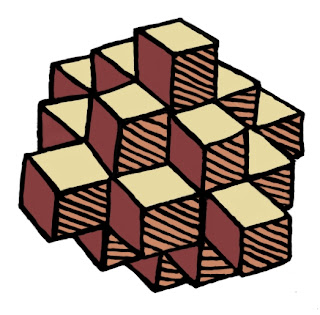 Just a small post on my birthday: a little present to you. In a world of Instagram snaps and Hipstamatic effects, actual hand work is undervalued these days, so I have sought a style for my blog posts which uses handmade illustrations. This also conveniently relieves me of the problems associated with copyright infringement.
Just a small post on my birthday: a little present to you. In a world of Instagram snaps and Hipstamatic effects, actual hand work is undervalued these days, so I have sought a style for my blog posts which uses handmade illustrations. This also conveniently relieves me of the problems associated with copyright infringement.Why Not Hand Illustrate?
All the logo work I have seen recently, for instance was done in Illustrator, a brilliant Bezier-spline-based tool for cleverly crafting the smooth edges of figures. And it has grown to be so much more, with its incredible control over negative and positive spaces. But, to me, there is a pleasure in crafting something by hand, shaping it, cleaning it up, styling it with real brush strokes, and hand-coloring it. There is so much more life in hand-illustrated artwork. Imperfection is simply part of the style.
 Hand Work: Bridging the Domains
Hand Work: Bridging the DomainsFor me, hand work always starts with real paper and a real ink implement. This used to cause me some worry: worry about making mistakes, blotting out a section, making a line too thin or too fat. But I have learned to just start over until I get something which is approximately right. I use this same approach in songwriting.
The reason for the "just good enough" approach is that I can edit it later using digital means. For music, perhaps I can use ProTools, Ableton, or even GarageBand to shape the final result and re-record overdubs. For artwork, I have confidence that I can make it right using similar hand work in the digital environment. Suddenly it becomes possible to rework "permanent" ink lines and even to erase them. Work that was simply impossible in the pen-and-paper domain. Suddenly, in the digital domain, we are in the world of undo and pure unadulterated color.
I use Painter with a Wacom tablet for this work, but, of course, it can also be done in Photoshop or any paint program with good support for a tablet. I also envision doing an increasing amount of work on my iPad. In the mobile environment I use a Wacom Bamboo stylus to do my drawing. Drawing with a finger, while interesting and convenient, is a bit restrictive and inaccurate. Especially with my big fingers.
For hand-drawn traditional artwork good scanner is always important for bridging these domains, and with this comes some tonal compression and re-interpretation of the colors of the work, which is why I stick to black-and-white for my sketches. This means that simple equalization and gamma correction can convert your sketch to something that becomes useful in the digital domain.
Hand Work Entirely in the Digital Domain
OK I lied. Sometimes my hand work doesn't always start with pen and paper. This is because there is also extreme value in starting in the digital domain and staying there. In this environment you have several advantages that are not present in the pen-and-paper domain. For instance: cloning.
A specific example is shown here.
But instead of cloning, this is more to the tune of using the original as a reference.
I proceeded by opening an image captured using an iPhone. Then I cropped it to a good size and brought the smaller image into Painter.
Once there, I created five serigraphy layers using Effects:Surface Control:Serigraphy. This mimics a silk screen process, and creates layers that I can move into any priority that makes sense.
Then I collapsed all the serigraphy layers into a single layer and proceeded to rework every edge in the layer, selecting colors, redoing edges using a tiger stripe look characteristic of woodcut or linoleum cut.
I had to introduce several new shadings where there was none before.
And I am left with a self-portrait in woodcut style. I would like to say that it only took a few minutes. But in fact it took several hours. Actually, I'm still not completely satisfied. I figure about twenty hours of work should do it. But who has time for that?

No comments:
Post a Comment